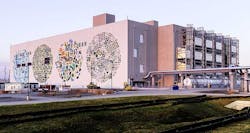The explosive growth of cloud computing has prompted Google to rethink how it constructs its data centers. To boost its cloud capacity, Google is going vertical with its server farms, shifting from a single-story design to four-story data centers.
The taller facilities allow Google to pack more servers into the same real estate footprint, providing more bang for its buck on each of its huge cloud campuses.
“In many of our campuses we’ve been doing multi-story buildings,” said Joe Kava, Vice President for Data Center Operations at Google. “The new facility in Mayes County, Oklahoma is four stories, and our most recent building in Iowa is also four stories.”
Design innovation is a critical piece of the cloud computing arms race, which is being waged with data centers. The new server farm design continues a major expansion of data center capacity at Google, which just announced plans to add 12 new compute regions for Google Cloud Platform over the next year.
“The movement to cloud is really accelerating,” said Kava. “There’s only been a few inflection points like this in the history of IT. I believe we will look back and see this as an important moment. This is really a transformational time.”
Cloud Economics Drives New Design
Google’s data center design evolution is driven by cloud economics. The company is relentlessly focused on economic efficiency in deploying new cloud capacity. Savings from a minor improvement in server design, or a small change in the price of electricity, are magnified when multiplied across Google’s hundreds of thousands of servers.
Cloud Scale: Rows and rows of server infrastructure inside the Google data center in Mayes County, Oklahoma. (Photo: Google)
Cloud campuses are where companies like Google concentrate massive amounts of computing power in multiple data center facilities. These data center hubs enable companies to rapidly add server capacity and electric power, creating economies of scale as more workloads migrate into these massive server farms.
Google has carefully selected the most affordable sites for building server farms, and wants to deploy as much capacity as possible at each of these locations.
“It’s a natural evolution of our campus strategy.” said Kava. “If you’re looking to preserve the amount of expansion on a campus, you look to densify and get the most out of every square foot, and that means multi-story.”
From Building Out to Building Up
When it began constructing its own server farms back in 2006, Google built one story facilities. It looked beyond the traditional data center hubs in Silicon Valley and Northern Virginia, opting to build in rural locations with an abundant supply of cheap land and electricity. This allowed it to build bigger data center footprints to accommodate more servers, creating the modern hyperscale data center.
Google first used a two-story layout in Finland in 2010, where it converted a large former newsprint factory in Hamina into a data center. The building had an unusually high ceiling, so Google installed a mezzanine floor so it could add more capacity. In 2013 it adapted a double-decker design for its “greenfield” ground-up projects, an approach it has deployed at scale in The Dalles, Oregon and Council Bluffs, Iowa.
With the new four-story data centers, Google is going vertical in an even bigger way. With data halls on each of the four floors, Google can dramatically increase the number of servers it can deploy on each square foot of real estate. This will extend the life of each of its data center campuses, allowing the company to focus its cloud capacity on the most affordable locations.
The new four-story data center at the Google campus in Council Bluffs, Iowa towers above the one and two-story data centers seen at left. (Photo: Google)
A Path Blazed by Carrier Hotels
Google isn’t the first company to operate a multi-story data center. From the earliest days of the Internet boom, servers and telecom equipment have been housed on the upper floors of skyscrapers in of major cities. These carrier hotels, like 60 Hudson Street and the Google-owned 111 8th Avenue in New York, provide services to the nexus of business customers in the central business district of these cities. But both power and real estate are expensive, and in limited supply.
Data center construction soon focused on the suburbs, and server farms grew horizontally, with single stories across larger footprints. As Internet growth has accelerated, Google hasn’t been alone in shifting to a multi-story model, as service providers like Digital Realty and CoreSite also use two- and three-story designs for their greenfield builds.
But Google’s shift to building up instead of out reflects the rapid growth of the company’s cloud platform. Google’s tallest company-designed building is in Singapore, where it operates a five-story data center. “In Singapore we needed to go multi-story because there isn’t a lot of land available,” said Kava.
Keeping the Generators Happy
The shift to multi-story data centers required some minor adjustments. One issue is testing that the equipment yard, which houses electrical and mechanical equipment, isn’t impacted by the proximity to a four-story building. Google uses computational fluid dynamics (CFD) to test the airflow in and around the equipment to ensure a proper working environment.
“One of the biggest considerations is your CFD modeling for air intake and exhaust, especially for generators and cooling towers,” said Kava. “If the wind is blocked by the building, it could affect the cooling towers. From a cooling perspective, you want to be careful to get that right.”[clickToTweet tweet=”Google’s Joe Kava: The movement to cloud is really accelerating. This is a transformational time for IT.” quote=”Google’s Joe Kava: The movement to cloud is really accelerating. This is a transformational time for IT.”]
Google continues to house its generators and cooling towers outside the building. The location of this equipment is a consideration in building multi-story facilities.
Some carrier hotels in city centers don’t have the luxury of land for an equipment yard, and house generators on upper floors and cooling towers on the roof of the building. This is not entirely without risk, as seen in an incident at 60 Hudson Street in February, in which a crane used for moving generators and air conditioning units collapsed into the street during a windstorm.
Will Google build even taller data centers? Kava noted that the economics begin to shift when you have to reinforce floors to house heavy equipment, which at some point could offset the benefits of the additional capacity.
“For us, it’s a matter of what makes financial sense,” said Kava. “There may be an inflection point on the construction costs on a dollar per kilowatt basis. With us it comes down to the economics.”
Creating A Giant Canvas
A view of the huge mural by artist Jenny Odell on an exterior wall of the Google data center in Mayes County, Oklahoma. “It’s a big wall and a big empty canvas,” said Google’s Joe Kava. (Photo: Google)
The multi-story design actually had a role in Google’s newest initiative: The Data Center Mural Project, in which local artists beautify the Google server farms with giant murals along the side of the building. The project had its genesis in a conversation between Kava and Urs Hölzle, Google’s senior VP for technical infrastructure.
“I was chatting with Urs and we were looking at photos of some of these new multi-story buildings,” said Kava. “They’re not very attractive, and we started brainstorming ideas around beautification.”
The folks at Google Creative Lab suggesting treating the massive data center walls as a large canvas, and inviting artists with ties to the local community to create murals. The project stands in contrast to years of practice of making data centers unexceptional to look at – usually large concrete blocks with minimal signage.
It’s also a reminder that the Google team is having fun, even as it races to build more data centers to power the Google Cloud Platform.
“Keeping up with the growth is fun if you love the data center industry, as our team certainly does,” said Kava. “This is the best time for data center engineers and builders.”






